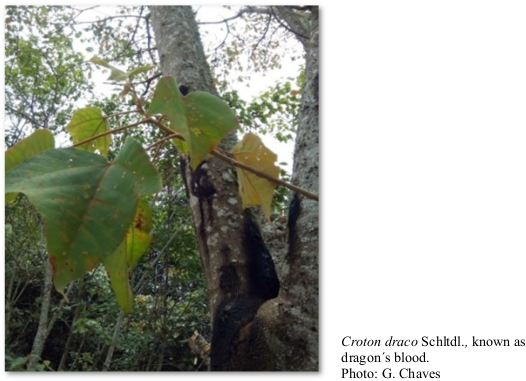Study on Croton sp. genetic diversity in the Department of Norte de Santander using the internal transcribed spacer (ITS) region of ribosomal DNA (rDNA)

Abstract
Genetic variability studies on species with a pharmacological potential are essential for conserving genetic resources. A genetic characterization of a species can guide efforts to collect and conserve germplasm for future breeding programs. The Croton genus belongs to the Euphorbiaceae family, which has approximately 1,300 species, is widely distributed in tropical and subtropical regions of the world, and has a wide range of ethnobotanical and medicinal uses. The aim of this research was to study genetic variability by analyzing sequences of the internal transcribed space region (ITS1 5'-TCCGTAGGGAACCTGCGGC-3' and ITS4 5'-TCCTCCGCTTATGC-3') of ribosomal DNA (rDNA) of a Croton population from forested areas in the Department of Norte de Santander in the municipalities of Chinacota, Pamplona and El Zulia. The results indicated considerable genetic variability in the Croton population, with a nucleotide similarity ranging from 54 to 99% and phylogenetical grouping according to the place of origin. The information gained from the ITS region can be a useful parameter for diversity evaluations and phylogenetic studies since there are no similar studies on Croton in this department in northeastern Colombia.
Keywords
Euphorbiaceae, Medicinal plants, Drago's blood, Neotropics, Genetic variability, Molecular systematics
References
- Berry, P.E., A.L. Hipp, K.J. Wurdack, B. Van Ee, and R. Riina. 2005. Molecular phylogenetics of the giant genus Croton and tribe Crotoneae (Euphorbiaceae sensu stricto) using ITS and TRNL-TRNF DNA sequence data. Am. J. Bot. 92(9), 1520-1534. Doi: 10.3732/ajb.92.9.1520
- Block, S., C. Baccelli, B. Tinant, L. Van Meervelt, R. Rozenberg, J.-L. Habib Jiwan, G. Llabrès, M.-C. De Pauw-Gillet, and J. Quetin-Leclercq. 2004. Diterpenes from the leaves of Croton zambesicus. Phytochemistry 65(8), 1165-1171. Doi: 10.1016/j.phytochem.2004.02.023
- Caruzo, M.B.R., B.W. Van Ee, I. Cordeiro, P.E. Berry, and R. Riina. 2011. Molecular phylogenetics and character evolution of the “sacaca” clade: Novel relationships of Croton section Cleodora (Euphorbiaceae). Mol. Phylogenet. Evol. 60(2), 193-206. Doi: 10.1016/j.ympev.2011.04.013
- Clark, K., I. Karsch-Mizrachi, D.J. Lipman, J. Ostell, and E.W. Sayers. 2016. GenBank. Nucleic Acids Res. 44(D1), 67-72. Doi: 10.1093/nar/gkv1276
- Costa, R.B., P. Martin de Moraes, L. Skowronski, C.E. Oliveira, M.L. Nogueira, R.M.S. Yui, A.P. Lorenz, and W.S. Fava. 2020. Genetic diversity and population structure of Croton urucurana Baill. (Euphorbiaceae) in Central Brazil by ISSR markers. Braz. J. Bot. (43), 831-838. Doi: 10.1007/s40415-020-00657-w
- Coy Barrera, C.A., D.C. Gomez, and F.A. Castiblanco. 2016. Importancia medicinal del género Croton (euphorbiaceae). Rev. Cubana Plant. Med. 21(2), 234-247.
- Farias, F.R., J.S. Williamson, S.V. Rodriguez, G. Angeles, and V.O. Portugal. 2009. Bark anatomy in Croton draco var. draco (Euphorbiaceae). Am. J. Bot. 96(12), 2155-2167. Doi: 10.3732/ajb.0900035
- Forough, J.F., T.A. Shivaji, and D.R. Mallikarjun. 2018. Assessment of genetic diversity among different sugarcane genotypes using internal transcribed spacer (ITS) region of the ribosomal DNA (rDNA). GSC Biol. Pharm. Sci. 5(2), 17-25. Doi: 10.30574/gscbps.2018.5.2.0108
- Godoy, G., L.E. Ojeda, V. Leon, F. Escalona, D. Mansilla, M. Brewer, N.N. Machado. 2020. Antimicrobial potential of Croton gossypiifolius (Euphorbiaceae) latex on species associated with human infections. Arnaldoa 27(1), 247-255.
- Kumar, S., G. Stecher, M. Li, C. Knyaz, and K. Tamura. 2018. MEGA X: Molecular Evolutionary Genetics Analysis across computing platforms. Mol. Biol. Evol. 35(6), 1547-1549. Doi: 10.1093/molbev/msy096
- Li, W., A. Cowley, M. Uludag, T. Gur, H. McWilliam, S. Squizzato, Y.M. Park, N. Buso, and R. Lopez. 2015. The EMBL-EBI bioinformatics web and programmatic tools framework. Nucleic Acids Res. 43(W1), W580-584. Doi: 10.1093/nar/gkv279
- Luján, M., Y. León, and R. Riina. 2015. Sinopsis de Croton (Euphorbiaceae) en los Andes de Mérida, Venezuela. Caldasia 37(1), 73-90. Doi: 10.15446/caldasia.v37n1.50815
- Mäder, G., P.M. Zamberlan, N.J.R. Fagundes, T. Magnus, F.M. Salzano, S.L. Bonatto, and L.B. Freitas. 2010. The use and limits of ITS data in the analysis of intraspecific variation in Passiflora L. (Passifloraceae). Genet. Mol. Biol. 33(1), 99-108. Doi: 10.1590/S1415-47572009005000101
- Masa-Iranzo, I., I. Sanmartin, M.B.R. Caruzo, and R. Riina. 2021. Skipping the dry diagonal: Spatio-temporal evolution of Croton section Cleodora (Euphorbiaceae) in the Neotropics. Bot. J. Linn. Soc. 197(1), 61-84. Doi: 10.1093/botlinnean/boab016
- Milanowski, D.J., R.E.K. Winter, M.P.F. Elvin-Lewis, and W.H. Lewis. 2002. Geographic distribution of three alkaloid chemotypes of Croton lechleri. J. Nat. Prod. 65(6), 814-819. Doi: 10.1021/np000270v
- Murillo Aldana, J.C. 1999. Composición y distribución del genero Croton (Euphorbiaceae) en Colombia, con cuatro especies nuevas. Caldasia, 21(2), 141-166.
- Perdue, G.P., R.N. Blomster, D.A. Blake, and N.R. Farnsworth. 1979. South American plants II: taspine isolation and anti-inflammatory activity. J. Pharm. Sci. 68(1), 124-126. Doi: 10.1002/jps.2600680145
- Riina, R., P. Berry, and B. Van Ee. 2009. Molecular phylogenetics of the Dragon’s Blood Croton Section Cyclostigma (Euphorbiaceae): A polyphyletic assemblage unraveled. Syst. Bot. 34(2), 360-374.
- Salatino, A., M.L.F. Salatino, and G. Negri. 2007. Traditional uses, chemistry and pharmacology of Croton species (Euphorbiaceae). J. Braz. Chem. Soc. 18(1), 11-33. Doi: 10.1590/S0103-50532007000100002
- Stöver, B.C. and K.F. Müller. 2010. TreeGraph 2: Combining and visualizing evidence from different phylogenetic analyses. BMC Bioinformatics 11, 7. Doi: 10.1186/1471-2105-11-7
- Van Ee, B.W. and P.E. Berry. 2010. Taxonomy and phylogeny of Croton section Heptallon (Euphorbiaceae). Syst. Bot. 35(1), 151-167. Doi: 10.1600/036364410790862461
- Van Ee, B.W. and P.E. Berry. 2011. Croton section Pedicellati (Euphorbiaceae), a novel new world group, and a new subsectional classification of Croton section Lamprocroton. Syst. Bot. 36(1), 88-98. Doi: 10.1600/036364411X553162
- White, T.J., T. Bruns, S. Lee, and J. Taylor. 1990. Amplification and direct sequencing of fungal ribosomal RNA genes for phylogenetics. pp. 315-322. In: Innis, M.A., D.H. Gelfand, J.J. Sninsky, and T.J. White (eds.). PCR protocols. A guide to methods and applications. Academic Press, San Diego, FL. Doi: 10.1016/B978-0-12-372180-8.50042-1
- Yang, S., X. Li, F. Huang, Y. Huang, X. Liu, J. Wu, Q. Wang, Z. Deng, R. Chen, and M. Zhang. 2018. A new method based on SNP of nrDNA-ITS to identify Saccharum spontaneum and its progeny in the genus Saccharum. PLoS One 13(5), e0197458. Doi: 10.1371/journal.pone.0197458
